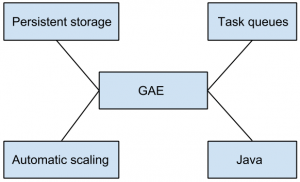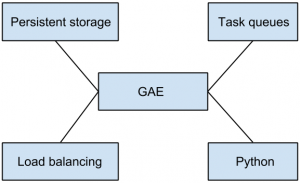This set of Cloud Computing Multiple Choice Questions & Answers (MCQs) focuses on “Google Web Services”.
1. Which of the following algorithm is used by Google to determine the importance of a particular page?
a) SVD
b) PageRank
c) FastMap
d) All of the mentioned
View Answer
Explanation: Content on pages is scanned up to a certain number of words and placed into an index.
2. Point out the correct statement.
a) With PaaS, the goal is to create hosted scalable applications that are used in a Software as a Service model
b) Applications built using PaaS tools need to be standards-based
c) In Wolf, the data and transaction management conforms to the business rules you create
d) All of the mentioned
View Answer
Explanation: Wolf lets you work with Adobe Flash or Flex or with Microsoft Silverlight.
3. Which of the following figure correctly describe major features provided by Google App Engine?
a) 
b) 
c) 
d) All of the mentioned
View Answer
Explanation: For an application to run on GAE, it must comply with Google’s platform standards, which narrows the range of applications that can be run and severely limits those applications’ portability.
4. Based on PageRank algorithm, Google returns __________ for a query that is parsed for its keywords.
a) SEP
b) SAP
c) SERP
d) Business Objects Build
View Answer
Explanation: SERP stands for Search Engine Results Page.
5. Point out the wrong statement.
a) Wolf Frameworks uses a C# engine and supports both Microsoft SQL Server and MySQL database
b) Applications built in Wolf are 50-percent browser-based and support mashable and multisource overlaid content
c) Google applications are cloud-based applications
d) None of the mentioned
View Answer
Explanation: Wolf has architected its platform so applications can be built without the need to write technical code.
6. Which of the following protocol lets a Web site list in an XML file information?
a) Sitemaps
b) Mashups
c) Hashups
d) All of the mentioned
View Answer
Explanation: Sitemaps can be useful in allowing content that isn’t browsable to be crawled.
7. Which of the following is not provided by “Deep Web”?
a) Database generated Web pages
b) Private or limited access Web pages
c) Pages without links
d) All of the mentioned
View Answer
Explanation: Online content that isn’t indexed by search engines belongs to what has come to be called the “Deep Web”.
8. Dynamic content presented in Google _______ crawling isn’t normally indexed.
a) AJAX
b) Java
c) Javascript
d) All of the mentioned
View Answer
Explanation: Google now has a procedure that helps the Google engine crawl this information.
9. Which of the following google product sends you periodic email alerts based on your search term?
a) Alerts
b) Blogger
c) Calendar
d) All of the mentioned
View Answer
Explanation: By creating a Google Alert, you can get email notifications any time Google finds new results on a topic that interests you.
10. Which of the following is a payment processing system by Google?
a) Paytm
b) Checkout
c) Code
d) All of the mentioned
View Answer
Explanation: Google Checkout was an online payment processing service provided by Google aimed at simplifying the process of paying for online purchases.
Sanfoundry Global Education & Learning Series – Cloud Computing.
Here’s the list of Best Books in Cloud Computing.
To practice all areas of Cloud Computing, Here is complete set of 1000+ Multiple Choice Questions and Answers.
If you find a mistake in question / option / answer, kindly take a screenshot and email to [email protected]- Check Cloud Computing Books
- Check Computer Science Books
- Practice Information Science MCQs
- Practice MCA MCQs
- Practice Computer Science MCQs
